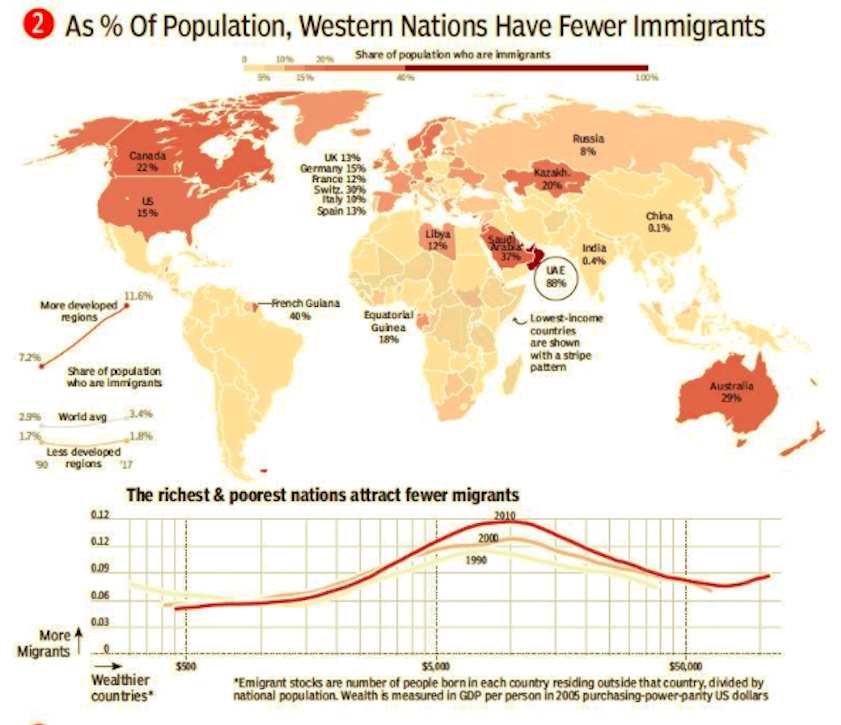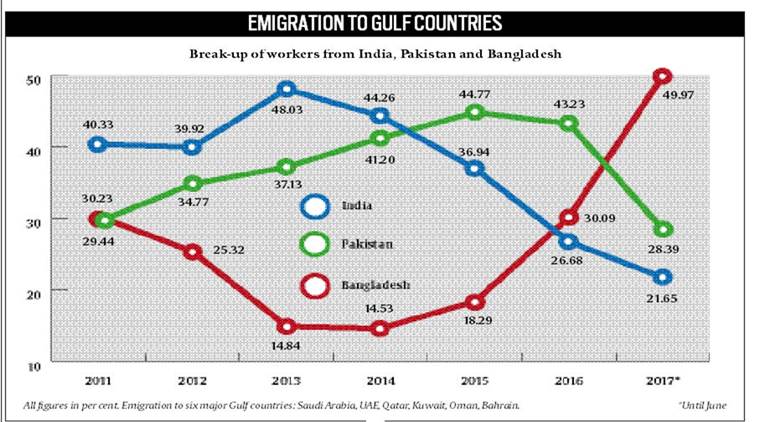Migration: South Asia
This is a collection of articles archived for the excellence of their content. |
Contents |
The status of migration
1990-2017: South Asia, other countries

From: August, 2018: The Times of India

From: August, 2018: The Times of India

From: August, 2018: The Times of India
See graphics:
Migration within regions and between regions, in 1990 and 2017, in Afghanistan, Bangladesh, China, India, Pakistan and other major countries
The countries that attract the most and the least migrants: 1990, 2000, 2010
Perceptions of native- born citizens about migration to their countries
Where immigrants go and what they do
August 13, 2018: The Times of India

ii) Foreigners who retained their nationality as % of population of host countries 2013;
iii) Estimate of illegal immigrants 2016; and
iv) Industry profiles by immigration status in United States, 2014
From: August 13, 2018: The Times of India
The tide of international migration has sparked strident reactions in host countries against the phenomenon. But immigrants make up only a small section of an advanced country’s population and seldom compete with citizens for well-paying jobs. A look at immigrant populations and jobs they fill...
Is international migration increasing over the years?
UN’s International Migration Report 2017 estimates there were 258 million immigrants in 2017. Between 1990 and 2017, the immigrant stock increased by over 100 million. Due to globalisation, more and more people are leaving their country of birth for those offer ing better opportunities. Also, the collapse of the communist bloc and the creation of a unipolar world triggered conflicts that saw people move to other countries. In 2017, India was the largest source of immigrant population while US was the biggest destination.
What is the composition of illegal immigrants and what happens on detection?
Data on regularisation of illegal immigrants in the advanced countries shows few common trends. The overwhelming majority of these immigrants are males under 40 years of age. Typically, nationalities accounting for the majority of these immigrants are determined by geographical proximity and understanding of local languages. Nearly all of these immigrants get employment in sectors requiring unskilled or low-skilled workforce. There are examples of regularisation — giving immigrants a path to residency or citizenship — being implemented as the only method to address this issue.
What percentage of foreigners are there a developed country’s population?
Most advanced economies have a significant share of foreign workers. Data from OECD — an organisation of advanced countries — shows that among large economies, Spain has the largest share of foreigners as part of its population. In 2013, more than 10% of Spain’s population comprised people from foreign countries who still held their nationality. The data may include people born in the host country but who hold nationality of their parents, but doesn’t include naturalised citizens.
What developed country has highest number of illegal immigrants?
It is very difficult to estimate the number of illegal immigrants. Also, different countries use different estimation techniques, making cross-country comparisons a difficult exercise. For EU, data for 2008 says there were an estimated 1.9m-3.8m illegal immigrants. Experts believe these numbers might have increased. For US, it is estimated there were 11.3m illegal immigrants in 2016, which is roughly 3.5% of the country’s population.
Migration from and to Bangladesh, India, Pakistan

See graphic:
Migration from and to Bangladesh, India, Pakistan, 2010-15
2001-11: India, Top source of migrants to OECD

Sources:
1. The Times of India, November 5, 2015
2. The Times of India, November 5, 2015
Lubna Kably
Indiaspora rising: Country top source of OECD migrants
123% jump in highly skilled people in 10 years
Both the countries of origin (where people emigrate from) and the pro ile of migrants has changed significantly in recent years. India now tops the list of countries of origin for recent as well as highly skilled migrants to member countries of the Organisation for Economic Co-operation and Development (OECD).
The 34 OECD membercountries include the European countries, the United States, Japan, Canada and Australia.
Indians also constitute the fourth largest diaspora in the OECD countries, according to a report re eased on Tuesday . India accounted for 8.95 lakh recent migrants above the age of 15 years in OECD countries during 2010-11.`Recent migrants' are those who have been in an OECD member-country for less than five years.
India was closely followed by Mexico (8.7 lakh) and China (8.2 lakh). OECD's report titled `Connecting with emigrants: a global profile of diasporas, 2015' noted that of diasporas, 2015' noted that in 2010-11, there were 3.1 crore highly educated migrants in OECD countries, an increase of 1.3 crore over a ten-year period. India contributed the most, with the number of highly skilled migrants from here having risen by 123% over the past decade to stand at 22.38 lakh in 2010-11.
The OECD also highlighted the growing importance of the Asian diasporas. At 38.36 lakh, India had the fourth largest diaspora, a growth of 83% over ten years.
The country was ranked ninth in 2000-01. “China and India, with about 39 lakh migrants each, have surpassed the diasporas of traditional OECD countries of origin of migrant population. This is an important change relative to the top five countries of origin in 2000-01, which were all OECD countries (viz: Mexico, UK, Germany , Italy and Poland),“ said the report.
Overall, in 2010-11, there were 11.3 crore migrants (all ages) in the OECD countries.The number of migrants aged 15 and above had increased by 40% since 2000-01 reaching 10.6 crore in 2010-11.
As regards the issue of brain drain, OECD's report doesn't comment directly on the Indian scenario, but points out that “the risk of brain drain is higher for SubSaharan Africa and Latin America, while it is less of a concern for other regions. For many countries, the rising educational attainment of their populations has mitigated the negative effects of the increasing numbers of their high-skilled migrants.“
An earlier OECD report had pointed out that the top five destinations for Indian migrants are: Australia, Germany , US, Canada and UK With a significant number of Indians overseas, US $71 bil lion was remitted to India in 2014, while the Chinese were remitted US $64 billion.
The dominance of Asia in highly skilled migration is al so reflected in the numbers of international students from the region. With 6.25 lakh stu dents in OECD countries in 2012, China is by far the top country of origin, followed by India with 1.68 lakh students The number of Chinese stu dents grew by 53% between 2008 and 2012, while that of In dians increased by just 3%.
Decline in emigration
2014-16: 35% fewer Indians emigrated; Pak, Bangladesh filled the gap

From: Ravish Tiwari, As fewer Indians went to Gulf, Pak, Bangladesh filled the gap, July 25, 2017: The Indian Express
From 2014-16, number of emigrating Indian workers fell 35%. Govt blamed lack of demand — actually, nature of South Asian Gulf labour pool is changing.
The government has blamed “lack of demand” for an almost 35% decline in the number of Indian workers emigrating to Gulf countries from 2014 to 2016. But emigration statistics compiled by The Indian Express from India, Pakistan and Bangladesh point to a significant underlying trend: workers from the two neighbouring countries have stepped up to meet demand following the dip from India.
Official data from the three countries on workers’ emigration to the six nations that comprise the Gulf Cooperation Council (GCC) — Saudi Arabia, UAE, Qatar, Kuwait, Oman and Bahrain — show a near 8.5% growth during this period. These six Gulf economies absorbed 19,01,356 workers in 2016 from the three major South Asian nations as against 17,52,734 workers in 2014.
The statistics (left) show that Indians comprised almost 48% of workers in the Gulf from the three countries in 2013, and a little under 27% in 2016. The share of Pakistani workers, in contrast, jumped from about 37% to 43% during this period. Bangladeshis registered a massive spurt from a little under 15% in 2013 to over 30% in 2016.
The emigration statistics in the first half of 2017 show that Pakistan and Bangladesh accounted for a 78% share in the GCC labour market from the three countries, with Bangladesh logging nearly 50%. Indians comprised just 22%, the figures show.
Responding to a question from Samajwadi Party MP Javed Ali Khan, the Ministry of External Affairs informed Rajya Sabha: “There has been a decline in the number of Indian workers emigrating to the Gulf countries for employment dues to economic slowdown in GCC countries triggered by the weak oil prices, which has resulted in lack of demand for workers.”
Statistics compiled by the Ministry showed that the number of Indian workers emigrating to the the GCC countries shrank by almost 35% from 7,75,845 in 2014 to 5,07,296 in 2016.
2014-16: Trend reversal in migration from Kerala
K R Rajeev, Migration from Kerala witnesses trend reversal, July 25, 2018: The Times of India
Emigration from Kerala to foreign countries has declined, probably for the first time after the first wave of emigration to the Gulf in 1960’s. The foreign ministry recently told the Parliament that the number of Indian workers emigrating to the Gulf for work has dropped in the past couple of years, possibly due to slowing economies in the region.
The Kerala Migration Survey-2016, conducted by Centre for Development Studies also shows an absolute decline in the total number of Kerala emigrants abroad from 2.4 million in 2014 to 2.24 million in 2016, constituting a drop of 1.54 lakh. It is for the first time the number has declined since CDS started conducting migration surveys in 1998. The preliminary findings of the survey conducted by S Irudaya Rajan shows that among the 14 districts, Thrissur has seen the steepest decline in the number of emigrants (75,355) followed by Ernakulam (71,740) when compared with 2013 figures.
Malappuram, which has the highest number of emigrants, also saw a decline (58,618) during the 2013-16 period. The survey however shows that Gulf region continues to be the favourite destination of migrants from the state with 89.1% of emigrants living in the six GCC countries. Among the non-Gulf countries, USA had the most number of emigrants (4.2%) followed by UK (1.6 %). Irudaya Rajan said that there are more fundamental factors which are affecting migration from the state to the Gulf than the slowing down of Gulf economies and the slump in oil prices. “I think the most important factor is the demographic contraction of Kerala's young population.
The people in the migration prone-age group of 20- 34 years has declined significantly in the state. While 42% of total population of the state in 1960 were in the age group of 0-14 years, it has dropped to just 23% in the 2011 census,” he said. Another reason is the steady decline in the wage differential between Kerala and Gulf, especially for blue collar jobs. “With no big money to be made in the Gulf, Keralites are not competing for low-income Gulf jobs,” he said. The youth from the state are reluctant to embrace unskilled, blue-collar jobs.
Significantly, the study has also for the first time in the last two decades shown a decline in remittance flow to the state from Rs 71,142 crore in 2014 to Rs 63,289 crore in 2016. “Any slackening in remittance flow is unthinkable as it would have serious consequences for the money-order economy of the state which contributes significantly to household income and consumption,” said K V Abdul Khader MLA, chairman on the assembly sub-committee on non-resident Keralites. He said that NRK's in the Gulf have been facing a series of setbacks in recent years in the form of growing nationalisation, rising costs of living and uncertainties caused by geo-political shifts. “But state and central governments have limitations in addressing the issue. However the state government is taking steps to support rehabilitation and skill development of Gulf returnees,” he said.
See also
Migration: South Asia
